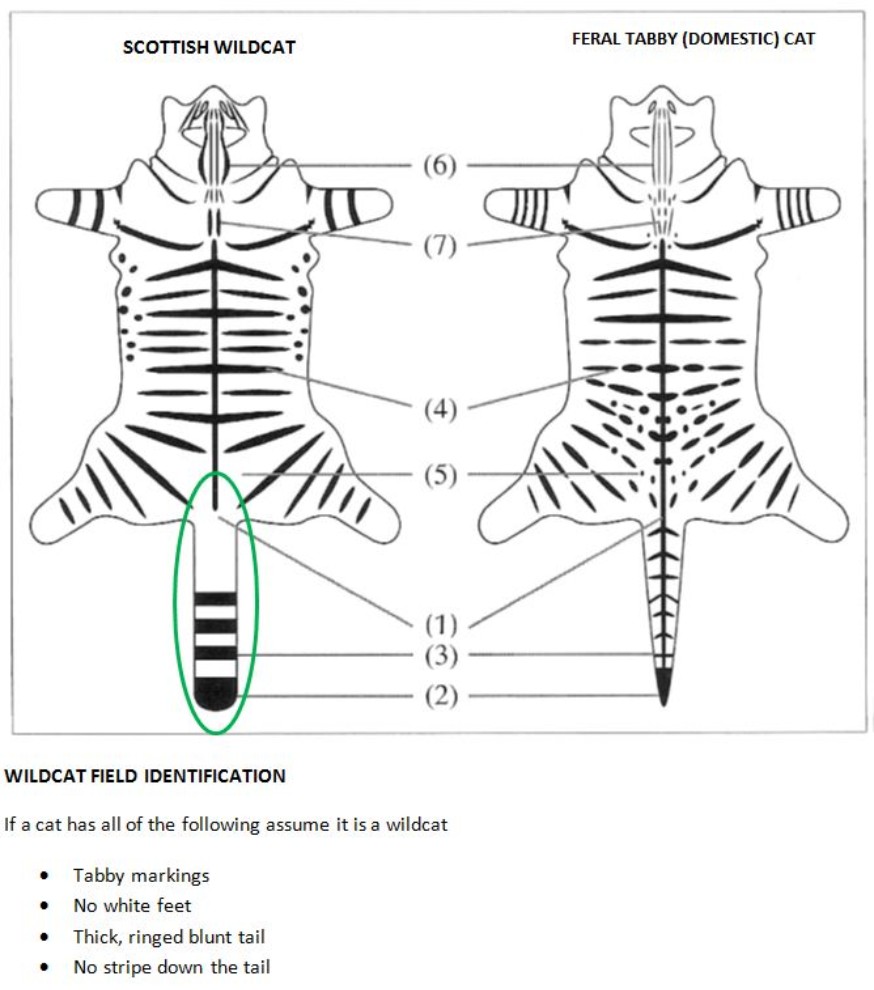Supporting guidance for Wildcat Friendly Predator Control
Date published: 25 January, 2023
For recent changes to this guidance, please see the bottom of the page.
The Wildcat Friendly Predator Control option helps to protect the Scottish wildcat by supporting land managers to undertake legal predator control using methods that reduce the risks to Scottish wildcats.
The Scottish wildcat, Felis silvestris, is the UK’s last remaining native feline species and it is in danger of genetic extinction.
The Scottish Wildcat Conservation Action Plan was launched in 2013 and it advocated addressing threats to wildcats in five Priority Areas. These were Strathpeffer, northern Strathspey, Strathavon, Strathbogie, Angus Glens and Morvern. Currently, the target area under this option is restricted to these Priority Areas. However, the work under the plan was superseded in 2020 by the Saving Wildcats project, which will continue limited work in the above Priority Areas alongside conservation breeding for release of wildcats into the Cairngorm Connect Area. Released wildcats are likely to move into surrounding areas, making wildcat safe predator control practices ever more important. NatureScot may consider endorsements from areas within or adjacent to the Cairngorm Connect Area.
If you wish to apply for this option, please email the NatureScot Mammals Advisor, who can provide support and advice at:
What does a Scottish wildcat look like?
Identifying wildcats in the field is difficult – they are superficially similar in appearance to domestic tabby cats. There are also hybrids between domestic cats and wildcats.
However, there are several important characteristics that can be used to identify wildcats at close quarters.

One of the main threats to wildcats is accidental persecution during legal control of feral cats and foxes by lamping, shooting and snaring.
There are legal requirements for carrying out predator control and industry codes of practice for lamping (night shooting) and snaring, and these should be followed.
This option asks land managers to follow the good practice protocol developed by the Scottish Wildcat Conservation Action Plan partnership – in addition to existing legal requirements.
It aims to reduce the risk of accidental killing or harming wildcats in the wildcat priority areas by providing support to land managers to take additional precautions to protect wildcats.
It includes support for the purchase of camera traps and live-capture cage traps and the additional staff cost to check this equipment and report findings.
What do I need to do?
Follow the Scottish Wildcat Conservation Action Plan land managers’ Scottish wildcat conservation protocol.
This includes:
- before undertaking any predator control, use local knowledge and results from camera trapping (to indicate whether or not an area is within a wildcat territory) to inform your choice of methods. (Where cameras are supported they should be checked at regular intervals over a period of one month prior to predator control operations and any cat images downloaded and submitted to the NatureScot Mammals Advisor)
- in any area where there may be known or suspected wildcat populations, use cage trapping to control feral cats rather than shooting or snaring. (Lamping may still be used to control foxes as the controller should be able to accurately identify the species before shooting. It is unlikely that snares can be set in such a way to select for foxes and avoid catching wildcats where they are present, hence snares should not be used for either feral cats or fox control in this situation)
- non-target species, including pet cats, should be immediately released unharmed and any injured wildcat should be immediately transferred to a local vet. As a precautionary principle, if you are in doubt about whether the cat you have caught is a Scottish wildcat, let it go
- take photos of any trapped cats (wildcats, hybrids or feral cats) as a record of their trapping and of their pelage markings. These should show side and top views, including tail and head. Send them to the NatureScot Mammals Advisor
- send hairs (complete with follicles) or tissues (blood or scat) found in a trap from any trapped wildcats or good-hybrids for genetic testing to the NatureScot Mammals Advisor
- pass all new records of wildcat sightings to the NatureScot Mammals Advisor
What information do I need to present and report?
In your application you should include:
- the areas where control will be undertaken (using land parcel identifiers or fids)
- the number of cameras and cage traps to be used
- number of days or nights that the activity will be undertaken in each month
- any predator control effort in the past five years
In your claim you should report:
- where cameras are used, numbers of wildcats, feral cats, hybrids and pet cats recorded in each month
- the number and type of species controlled using this protocol (which may include feral cats, foxes, mink) and the methods used to catch and dispatch them
- the number and type of animals released using this protocol (all non-target species)
Further information
Recent Changes
| Section | Changes |
|---|---|
| Opening section | Revised/added text about the latest positon on the Wildcat Friendly Predator Control option |
| What do I need to do | Removal of final bullet. Documentation now to be sent to NatureScot Mammals Advisor |
| Further Information | New added links and corrections to broken links |
